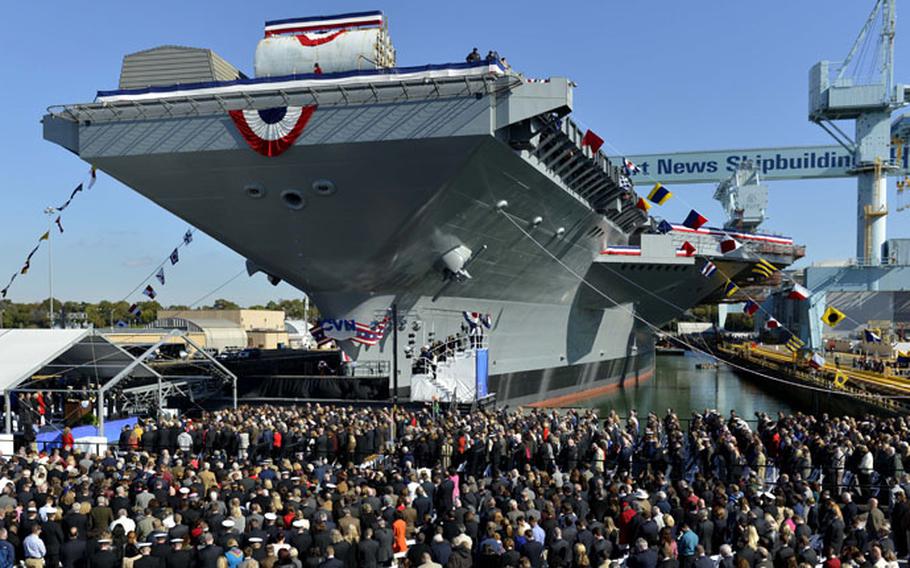
Servicemembers and distinguished guests bow their heads as Navy Capt. Jerome Hinson gives a benediction during the Gerald R. Ford's christening ceremony last November in Virginia. A General Accountability Office study released Nov. 20, 2014, states that the aircraft carrier will likely be incomplete and require more spending after its planned 2016 delivery to the Navy. (Patrick Grieco/U.S. Navy)
YOKOSUKA NAVAL BASE, Japan — The Navy plans to meet the $12.9 billion cost cap for its new aircraft carrier by accepting the ship unfinished and spending more money afterward, according to a report by the government’s watchdog agency.
The aircraft carrier Gerald R. Ford may be unable to demonstrate its promise to boost aircraft launch and recovery rates before it is delivered to the Navy, according to a Government Accountability Office report released Thursday.
The ship may also require as much as $988 million more in spending after delivery, according to the GAO.
“In essence, the Navy will have a ship that is less complete than initially planned at ship delivery, but at a greater cost,” according to the report.
The Gerald R. Ford is about 80 percent complete and is about to begin shipboard testing, which the GAO considers the most challenging phase of development.
Construction has begun concurrently on the new aircraft carrier John F. Kennedy. The Navy plans to spend $43 billion on three Ford-class carriers.
Since 2006, cost estimates for the first Ford-class carrier have already risen 20 percent. Delivery has been delayed from September 2015 until March 2016.
Once completed, the Navy states that the Ford-class carrier will provide several advantages over its 10 active Nimitz-class carriers.
For example, an electromagnetic field, instead of steam catapult launchers, to propel aircraft off the deck will ease wear and tear on the carrier.
Replacing cables with electromagnetic fields to transport weapons is expected to increase payload capacity by 229 percent, according to the report.
Other changes should improve radar detection, reduce manning and trim long-term costs.
However, GAO states that the ship will not be able to demonstrate some of its biggest technological advances prior to deployment, under its current test schedule.
“After an investment of at least $12.9 billion, CVN 78 may not achieve improved operational performance over the Nimitz class of aircraft carriers as promised for some time to come,” GAO said.
The CVN78 program office has created a $96 million reserve fund for spending above the $12.9 billion cap.
However, Naval Sea Systems Command Cost Engineering Office estimates a cost overrun ranging from $780 million to $988 million.
The report also criticized the ship’s design for not including enough berths if additional personnel are needed, which the GAO views as likely.
The Pentagon disagreed with a GAO recommendation that Congress revise cost caps to more accurately reflect real spending.
“The Department acknowledges that remaining within the cost cap is challenging, but contends that it is achievable,” according to a Defense Department memo appended to the report.
The memo did not directly address the timeline and design issues identified by the GAO.